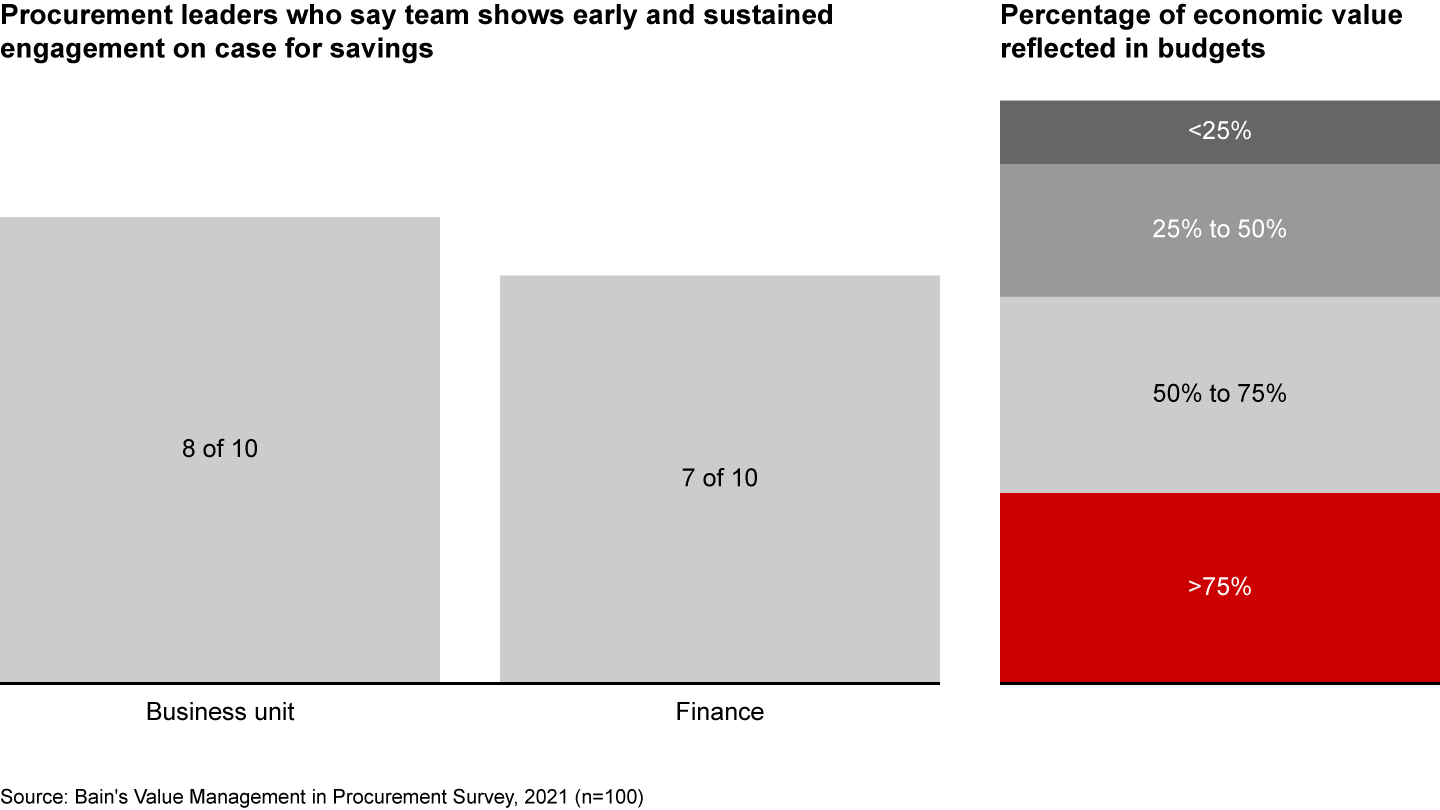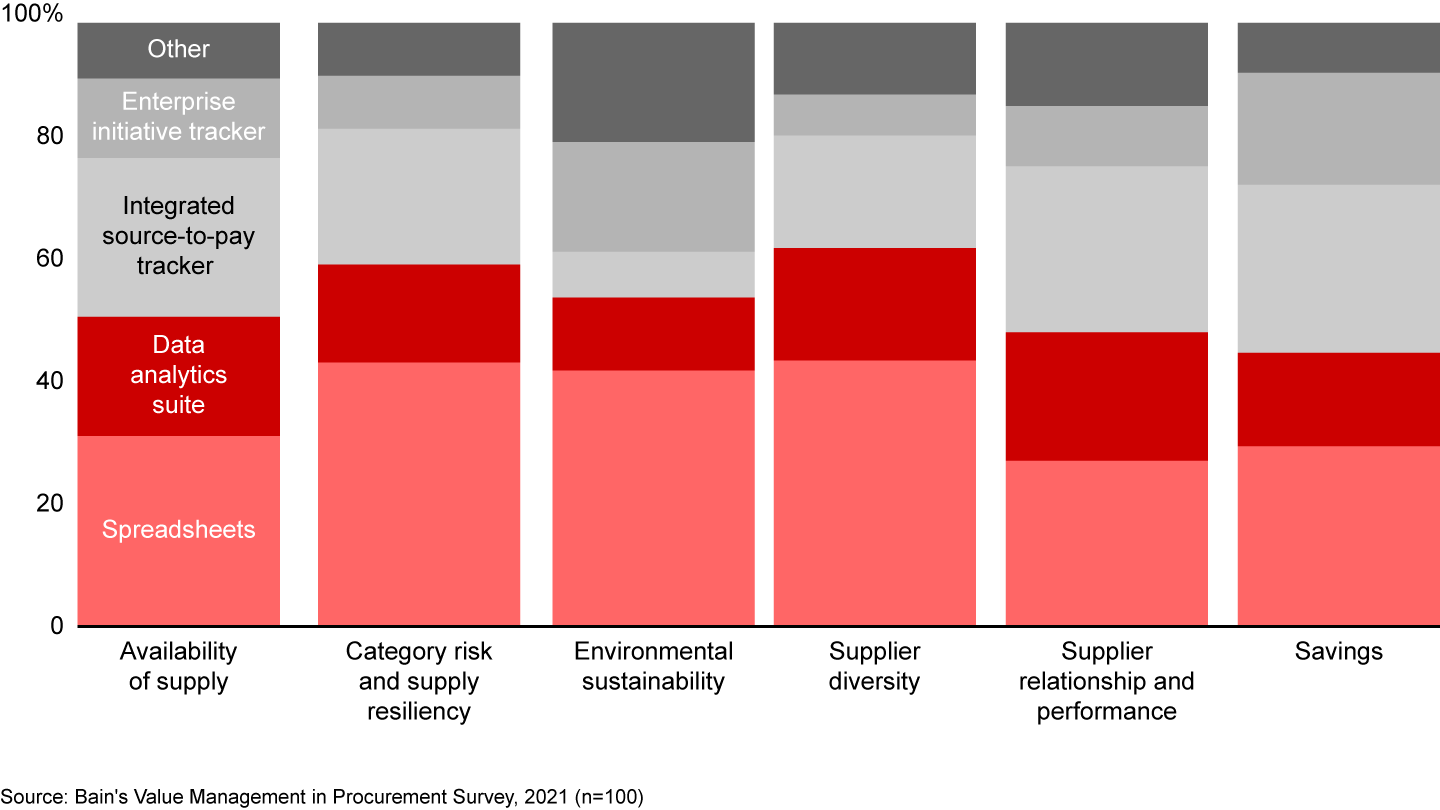Article

It’s shaping up to be a big year for procurement organizations: Fortune 500 companies will oversee the purchase of more than $5 trillion in goods and services in 2022, all while navigating unprecedented inflation and supply shortages. Despite these headwinds, CEOs, CFOs, and boards expect procurement organizations to create and manage not only traditional value, including savings, but also an evolving array of value beyond savings.
Procurement leaders still need to prioritize capturing savings and mitigating cost increases—in fact, it’s more critical than ever. When building the case for savings, many global procurement leaders felt they had early and sustained engagement from business leaders and the finance team, according to a recent Bain survey. However, only a fraction of Chief Procurement Officers (CPOs) saw more than 75% of the economic value they identified recognized by finance and reflected in business unit budgets (see Figure 1). In other words, 7 out of 10 procurement teams saw at least a 25% savings yield loss from their savings initiatives.

At the same time, business stakeholders’ expectations of procurement are evolving. They no longer view procurement as a reactionary support function. Procurement’s mandate has evolved from managing an efficient requisition-to-pay process, to serving as an engine for cost savings, to helping the firm meet an evolving array of objectives. Today, CEOs, business customers, and finance teams are putting pressure on CPOs to identify, quantify, and realize value in ESG, supplier diversity, and supply risk mitigation initiatives (see Figure 2).

Tracking and balancing the many competing objectives of the business, finance department, and other stakeholders is a growing challenge for global procurement leaders and the broader organization. It’s common to see multiple tools and trackers within the same organization—in some cases, even in the same department—as an attempt to collect and reconcile value across multiple initiatives (see Figure 3). Many are homegrown solutions built in Microsoft Excel, Power BI, and Tableau.

Beyond tools, methodologies, and processes, perhaps the largest challenge facing value management stems from the procurement organization itself. Procurement teams often treat value management as an afterthought to critical decisions around strategy, planning, operating model, and digital tools. That’s a big miss: In world-class procurement organizations, firm objectives are at the forefront of decisions in each of these areas as part of a comprehensive plan to generate value beyond savings. The best procurement leaders examine whether their organization and operating model, talent and capabilities, and digital roadmap are fit for purpose, based on the firm’s value objectives.
To take this comprehensive approach to value management, many procurement leaders will have to transform their teams. But first, they will need to clarify the objectives of various stakeholders. It will be critical to prioritize and mitigate conflicts around competing objectives. From there, procurement leaders can translate priorities into tangible targets that they can track and execute against. These steps can help ensure the value strategy dictates the makeup of the capabilities, organization, operating model, and digital tools.
While the path ahead may seem daunting, procurement leaders can get started by asking a few key questions:
- How do the objectives of our business customers and finance stakeholders translate into our value management process?
- How do we define, estimate, baseline, track, and reconcile value? And who is responsible for the validation of past and future value?
- What are the critical capabilities required to meet our value objectives?
- Is the organization designed around capabilities that help us meet our value objectives?
- How does our digital strategy help functions deliver clear value?
Leading organizations will unlock powerful procurement advantages through a thoughtful and integrated approach to value management that aims to prioritize stakeholder objectives. Superior procurement teams will achieve this not only through value tracking tools, but also through a strategy that harmonizes their organization, talent, and digital capabilities with the firm’s mission and objectives. This will be especially critical as the procurement mandate continues to expand.


